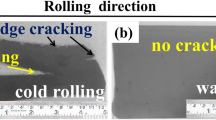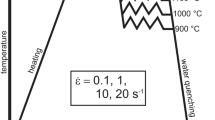The distribution of material properties in a forged part used to make reference specimens was studied. The objective was to determine why the scatter of data was so large in tests of temperature reference specimens of VVER-1000 base metal on the metal of a sampling ring of a regular VVER-1000 casing. The tests were performed on Charpy and rupture samples, and the hardness was measured and the chemical composition studied. It is shown that the scatter is mainly due to the fact that the reference specimens of the VVER-1000 base metal were cut from the end of the forged part, where, characteristically, a property gradient exists along the vertical coordinate with the critical brittleness temperature decreasing significantly toward the top boundary of the forged part. The scatter of the initial critical brittleness temperature for the control and temperature groups was evaluated within the framework of a virtual experiment simulating a study of reference specimens with prescribed property variation.
Similar content being viewed by others
References
PNAE G-7-002-86, Norms for Calculating the Strength of Equipment and Pipelines of NNP, Energoatomizdat, Moscow (1989).
A. A. Chernobaeva, N. A. Shulgan, Ya. I. Shtrombakh, et al., ”Mechanical properties distribution in welds and forged parts of VVER-1000,” in: Proc. PVP 2009 ASME Pressure Vessels and Piping Division Conf., Prague, Czech Republic, PVP2009, I821CD.
A. A. Chernobaev, Validation of Models of Radiation Embrittlement of Reactor Vessel Materials and Procedures for Using Them to Determine the State of Operating Reactor Vessels: Auth. Abstr. Doctoral Dissertation in Technical Sciences, Moscow (2009).
B. Z. Margolin, V. A. Nikolaev, and E. V. Yurchenko, “Analysis of the embrittlement of VVER-1000 reactor vessel materials during operation,” Vopr. Materialoved., No. 4(60), 108–123 (2009).
B. Z. Margolin, V. A. Nikolaev, E. V. Yurchenko, et al., “New approach to describing the embrittlement of VVER-1000 reactor vessel materials during operation,” Probl. Prochn., No.1, 7–26 (2010).
M. A. Skundin, A. A. Chernobaeva, D. A. Zhurko, et al., “Study of property distribution in unirradiated reactor vessel casings of NPP,” Deform. Razrush. Mater., No. 10, 41–44 (2011).
Author information
Authors and Affiliations
Additional information
Translated from Atomnaya Énergiya, Vol. 113, No. 6, pp. 337–343, December, 2012.
Rights and permissions
About this article
Cite this article
Chernobaeva, A.A., Nikolaev, Y.A., Skundin, M.A. et al. Analysis of the reasons for the scatter of the data on temperature reference specimens of VVER-1000 base metal. At Energy 113, 420–428 (2013). https://doi.org/10.1007/s10512-013-9656-4
Received:
Revised:
Published:
Issue Date:
DOI: https://doi.org/10.1007/s10512-013-9656-4




